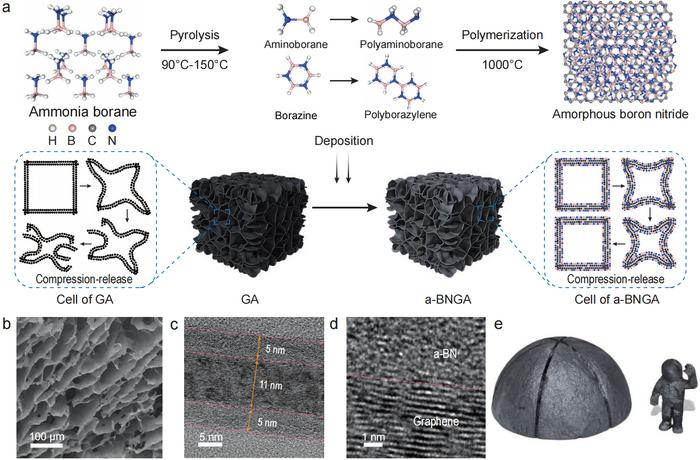Thermal superinsulation materials, which have low thermal conductivities, are necessary for protection and thermal insulation in adverse conditions. Such materials are especially needed in fields such as aerospace, mechanical, deep-space exploration, and thermal power engineering, which require outstanding reliability and stability.

(a) Illustration of the fabrication process of a-BNGA. (b) SEM image of a-BNGA framework. (c,d) TEM image of a-BNGA cell wall cross section with multi-nanolayer structure.(e) Optical photograph of a-BNGA with spacesuit and lunar base shapes. Image credit: Science China Press
Inorganic aerogels have shown several superior features like high deformability, ultralight weight, low thermal conductivity, and excellent fire/corrosion resistance, establishing potential as thermal insulators. Nevertheless, inorganic aerogels are still afflicted by a compromise between their thermal and mechanical characteristics, which presents a key roadblock to further examining their functionality.
While improvement in thermal or mechanical characteristics has been well examined in inorganic aerogels, there is still a lack of effectual synergistic approaches to resolving this characteristic tradeoff.
In a new study article published in the National Science Review, scientists at Harbin Institute of Technology and Southeast University present a chemically bonded multi-nanolayer design and synthesis of a graphene/amorphous boron nitride aerogel (a-BNGA) to improve the thermal and mechanical properties concurrently. Unlike in earlier work, the graphene framework is evenly deposited by a-BN nanolayer on both sides, thus making a chemically bonded multi-nanolayer structure.
It was determined that the chemically bonded interfaces firmly anchor the uniform a-BN jacket onto the graphene skeleton, serving through a tendon-like mechanism, guaranteeing a load transfer and synergistic deformation in the framework. The a-BN nanolayer can enhance the elastic firmness of cell walls. It gives a necessary bending moment distribution, which realizes a coupled toughening effect to improve the structural strength.
The consequent a-BNGA exhibits an ultralow density with ultrahigh flexibility (elastic bending strain up to 90%, elastic compressive strain up to 99%) and outstanding thermal stability (nearly no strength degradation post sharp thermal shocks). The scientists establish flexible deformability with an unfolding and folding process of the aerogel flower in a human hand.
Remarkably, the a-BN nanolayer in aerogel, exceeding 20% in volume, is mechanically critical but thermally inactive—a perfect state for thermal insulation materials. The solid conduction and radiation contributions jointly contribute to the obvious thermal conductivity of the material in a vacuum. Getting benefit from the shortage of effective conduction paths by low density and the extra phonon scattering by the interface, solid conduction can be successfully reserved.
In addition, graphene can be employed as an infrared absorber to minimize radiative thermal transport. The scientists experimentally demonstrated this aerogel with record-low thermal conductivity in a vacuum among freestanding solid materials until now. Besides, they developed a lunar base model operating in high-vacuum to establish the thermal superinsulation abilities of aerogel in extraterrestrial exploration applications.
We achieve a combination of exceptional mechanical and thermal properties of inorganic aerogel and defining a robust material system for thermal superinsulation at extreme conditions, such as lunar and Mars bases, satellites and spacecrafts. This kind of material and structural design may also provide opportunities for inorganic aerogels to endow other unique functions.
Prof. Xiang Xu, Harbin Institute of Technology and Southeast University